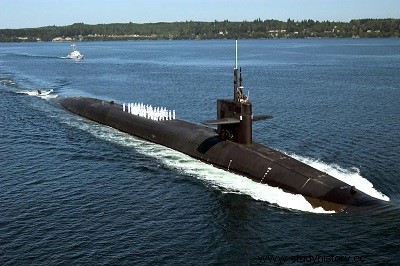
While the Polaris were replaced by the Poseidon in the early years '70, a new SLBM ballistic missile program was launched, the Trident. The first model of this program (Trident I) has a range of 7,200 km from a huge 18,700 ton launcher submarine, capable of loading twenty-four machines. During the course of the program, in the 1980s, the improved Trident II will be put into service with a range of more than 10,000 km, to replace the Trident I already deployed. While controversies over the cost overruns of this huge program delayed its entry into service, the Soviets developed the SS-N-8, with a range of 7,500 km, aboard the Delta-class submarines ( in 1972); the first SS-N-8 of an improved range version (over 10,000 km) was fired in 1976. The American reaction was to accelerate the Trident program and the first Ohio-class launch submarine, the Ohio (SSBN-726), was laid down on April 10, 1976; since then, Michigan (SSBN-727) has followed, and eight other submarines of the same type are planned. Entry into service (first planned for 1979) was delayed for three years. The total number of Trident-launching submarines depends on two factors:first, the terms of the SALT-II agreement, still under negotiation in early 1979, and any future agreement between the Soviet Union and the United States. United. This type of agreement will have to determine the authorized number of ballistic devices launched from submarines. The other factor is the possible development of a cruiser, which can be used for strategic missions from the torpedo tube of a submarine. Developments in this area could reduce the importance of SLBMs. The great advantage of the new generation, very long range SLBMs is that they can intervene from areas close to the country of origin, which makes it extremely difficult to destroy the device before it is fired. The weakness of the Ohio class, its immense dimensions, which normally make it an easier target to detect, does not therefore constitute an insurmountable handicap.
With the end of the Cold War and the nuclear arms reduction treaties, the first four submarines of this class (USS Ohio, USS Michigan, USS Florida and USS Georgia) were transformed in 2007 into SSGNs like the submarines Russian Oscar-class cruise missile launchers capable of carrying 154 conventionally charged Tomahawk missiles and 66 special forces commandos. Their first combat use was on March 20, 2011, when the USS Florida (SSGN-728) participated in strikes during the implementation of the no-fly zone over Libya.
A deterrent patrol lasts an average of 90 days but can go up to 105 days.
In 2012, the oldest Ohio-class vessel, USS Henry M. Jackson (SSBN-730), is scheduled to be decommissioned in 2027 after 42 years of service. The Navy will then retire the remaining 13 Ohio-class SSBNs at a rate of one per year, the last in 2040.
List of buildings
Nuclear cruise missile submarine
USS Ohio (SSGN-726)
USS Michigan (SSGN-727)
USS Florida (SSGN-728)
USS Georgia (SSGN-729)
Nuclear ballistic missile submarine
60% of the American submarine nuclear capacity is, in 2009, deployed in the Pacific Ocean (against 15% during the 1980s) with 6 SSBNs stationed in Kings Bay, on the Atlantic coast, and 8 in Bangor, on the Pacific coast:
USS Henry M. Jackson (SSBN-730)
USS Alabama (SSBN-731)
USS Alaska (SSBN-732)
USS Nevada (SSBN-733)
USS Tennessee (SSBN-734)
USS Pennsylvania (SSBN-735)
USS West Virginia (SSBN-736)
USS Kentucky (SSBN-737)
USS Maryland (SSBN-738)
USS Nebraska (SSBN-739)
USS Rhode Island (SSBN-740)
USS Maine (SSBN-741)
USS Wyoming ( SSBN-742)
USS Louisiana (SSBN-743)
Crashes
On March 19, 1998, the surface-going USS Kentucky (SSBN-737) struck the submerged Los Angeles-class SNA USS San Juan (SSN-751) off Long Island. The accident, which did not cause any casualties, is attributed to human error
Popular culture
One of the Ohio-class submarines, USS Alabama appears in the film of the same name in which Russian ultranationalists seize an ICBM base and threaten to launch them at the United States, which retaliates by sending Alabama destroy the silo.
In the Last Resort series, the submarine is also Ohio class.
Ohio-class ballistic missile submarines
Displacement: 16,000 tons on the surface (18,700 submerged).
Dimensions:
overall length 170.7 m;
beam 12.80;
draft 10.8 m.
Armament: twenty-four vertical ballistic missile launcher tubes (SLBM) Trident I, in two rows of twelve behind the kiosk; four 533 mm torpedo tubes in the hull.
Propulsion :a General Electric S8G reactor, a set of GE gas turbines. Total power and speed in immersion kept secret.
